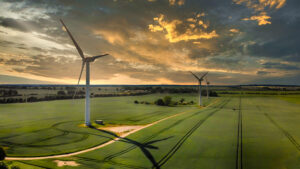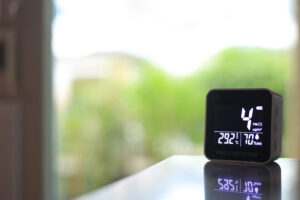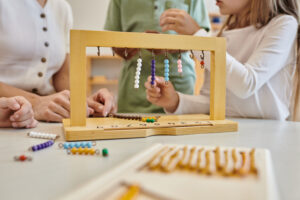- 7 min reading time
Splashback in the kitchen - which back wall fits?
Especially for this use, we do not consider: plaster or concrete, which are used more for whole walls, as well as small splashback folding walls, which are not a permanent solution. We also leave out too delicate materials such as natural stone and wood. Both can create a wonderful atmosphere in the kitchen and, with the right coating, are ideal for kitchen walls. But not for the splashback behind the hob and sink, of all things.
Finally, a brief note on wallpaper protective paint. Around wet areas, such paints are an alternative, but not in the immediate vicinity of hotplates.
Funktionen und Möglichkeiten eines Spritzschutzes
Der Spritzschutz ist in den meisten modernen Küchen nicht mehr wegzudenken und zu einem unverzichtbaren Teil der Grundausstattung geworden. Er bewahrt nicht nur die Schönheit und Hygiene der Küchenrückwand, sondern auch ihre Struktur und sorgt für Langlebigkeit. Dabei erfüllt der Spritzschutz nicht nur seinen funktionalen Zweck, sondern setzt auch stilvolle Akzente in der Gestaltung der Küche. Ihr Designspielraum und die Auswahl des Materials werden jedoch maßgeblich durch die gewählte Anbringungsmethode entschieden.
Spritzschutz kleben oder festschrauben?
Grundsätzlich stehen Sie vor der Wahl, ob Sie den Spritzschutz an Ihre Küchenrückwand kleben oder festschrauben möchten? Beide Optionen haben ihre Vor- und Nachteile, sind unterschiedlich aufwändig und hängen stark von Ihren individuellen Bedürfnissen und persönlichen Vorlieben ab.
Einen Spritzschutz zu verkleben ist besonders einfach. Die Anbringung ist schnell und erfordert keine speziellen Werkzeuge oder handwerklichen Fähigkeiten. Die Klebevarianten sind schonender für die Wand, da sie keine Löcher erzeugen. Dies kann besonders wichtig sein, wenn es um Mietwohnungen geht. Hinzu kommt, dass viele Klebeprodukte mehr Flexibilität bei der Platzierung des Spritzschutzes bieten. Sie können leicht angepasst oder entfernt werden, falls eine Änderung oder Renovierung erforderlich ist. Dafür sind Klebebefestigungen nicht besonders tragfähig und halten kein schweres Gewicht, wie einen Spritzschutz aus Metall. Besonders billige Produkte wie Klebefolien haben eine geringe Haltbarkeit, die im Laufe der Zeit nachlässt, insbesondere wenn sie Feuchtigkeit und Hitze ausgesetzt sind. Dies kann zu Beschädigungen oder Ablösungen von der Wand führen.
Ihren Spritzschutz mit Schrauben an der Wand zu befestigen, bietet eine hervorragende Stabilität. Die robuste Befestigung ist besonders wichtig für schwere oder großformatige Spritzschutzpaneele. Dadurch ermöglichen festgeschraubte Produkte eine größere Vielfalt an Materialien und Designs. Im Gegenzug ist auch der Aufwand der Installation deutlich zeitintensiver, erfordert Werkzeug und handwerkliches Geschick im Vergleich zum Kleben. Es können auch spezielle Befestigungselemente und Vorkehrungen erforderlich sein. Außerdem hinterlässt das Bohren Löcher in der Wand, die bei einer späteren Entfernung des Spritzschutzes repariert werden müssen. Nachdem der Spritzschutz befestigt wurde, ist es schwieriger, ihn zu versetzen oder zu entfernen, ohne Reparaturen an der Wand vorzunehmen.
Insgesamt lässt sich sagen, dass die Wahl zwischen Festkleben und Festschrauben von der Wahl des Materials, der verfügbaren Zeit und handwerklichen Kenntnisse abhängt. Hinzu kommt die preisliche Komponente, denn schweres Material, das in der Regel angeschraubt werden muss, ist meist teurer.
Price comparison
For the relatively small areas of a commercial kitchen for families, the acquisition costs range across the board approximately between €15 and €100 - for less than one square meter of space. The differences within a segment can be almost as great. When it comes to whether the installation is not better in professional hands, larger differences also occur. A professional tiling strikes fast between 150 € and 200 € per square meter. Safety glass walls also belong to the high-priced segment.
Material costs for orientation
Splash guard adhesive films
middle price range: approx. 20 - 50 €
Wall splashback made of various plastics and metals
high price range: approx. 50 € - more than 300 €
Ceramic tiles, safety glass wall splashback
Ceramic tiles
However, nothing works with ceramic tiles without joints. They are a dirt trap, regardless of whether they are on the floor or on the wall - even if the tiles themselves can be cleaned quickly and easily. How well they seal also depends on the care with which the tiles were installed.
For more than a small handful of tiles, we always recommend calling in a professional. Remember: the tiles should be aligned with the plumb so that they hang straight. The distances from each other should be the same on all sides. Anything else looks unsightly and looks unprofessional.
One advantage over complete wall coverings is the particularly large selection of motifs. As part of a rustic kitchen, for example, you can set great accents.
Advantages
- durable, robust
- Tiles easy to clean
- good mechanical protection
Disadvantages
- Replace if damaged, do not patch
- Joints comparatively not easy to clean
- Installation laborious, dusty, possibly costly
- not easy to apply on old pavement
Glass plates
For a glass surface (only recommended in one piece) please use only ESG glass (safety glass). This is particularly impact-resistant, scratch-resistant and heat-resistant. Acrylic glass or Plexiglas are thermoplastic materials. They are not suitable for areas around the stove and hotplate, as they can quickly deform under the heat that is usually generated there.
Als Wandverkleidung unbrauchbar bietet eine Glasplatte besonders viele Gestaltungsmöglichkeiten, indem man beispielsweise ein Foto oder sogar Beleuchtung dahinter anbringt. Andererseits können etwa Mustertapeten oder Steinwände auch transparent abgedeckt werden.
In terms of care, glass plates are quite insensitive. With a normal glass cleaner and a soft cloth, dirt of any kind is quickly and thoroughly removed.
It is not quite as easy to attach the glass plate. Gluing over old coverings is no problem with the right silicone adhesive if the lower covering holds the additional and not inconsiderable weight of the glass plate on the wall. Variants with screw connections are less recommendable. Dirt that then accumulates behind the glass plate usually stays there.
Advantages
- ESG glass: very robust and heat resistant
- easy to clean / maintain
- Design variety through printing
Disadvantages
- ESG glass can be cut only once, not corrected
- Acrylic and plexiglass not heat resistant, therefore unsuitable
- rather for smaller areas (weight)
Aluminum or stainless steel
From a hygienic point of view, these products are just as high quality as ESG glass panels. Commercially available cleaning agents are perfectly sufficient for easy care.
Stainless steel and aluminum can also be printed well from the face side. However, suitable coatings such as transparent liquid laminate should be used. This ensures heat resistance and protects the print. Without printing, aluminum and stainless steel appear somewhat colder and possibly less aesthetic. In addition, scratches and other mechanical marks can then be detected more quickly. In this condition, care should also be taken when choosing cleaning agents.
On old tiles, the panels can usually be glued very well. Alternatively, they can be riveted, for example, on wooden back walls.
Advantages
- heat resistant and unbreakable
- can also be edited afterwards, re-cut
- Design variety through printing
- cheaper than ESG glass
Disadvantages
- unprinted scratches are quickly visible
- wrong detergents can leave traces
Plastic wall protection panels
Plastic sheets as splash guards have many advantages when they are designated as heat resistant.
Sufficiently heat-resistant splashback walls for private kitchens combine many advantages of other coverings. They are easy to glue without any problems, provided that the substrate is solid and dust-free. In addition, they are also easy to work with later - for example, if you forgot the two sockets between the stove and sink when ordering.
The design options offered by a large selection of print motifs has something for every taste. Differences between e.g. natural stone motifs and real stone are almost no longer recognizable at a normal distance. Once applied, plastic plates are break-proof and in the case of particularly strong mechanical stress, pressure marks balance themselves out again.
For hygiene, plates made of one piece are of course the best choice. Care is quick and easy with standard household products. Scratches and surface damage are not to be expected unless you are constantly hitting the material with a butcher's axe.
Im Gegensatz zu Fliesen, Edelstahl und Aluminium sind viele Kunststoff-Verkleidungen sogar für den großflächigen Einsatz gedacht. Gerade aus gesundheitlich unbedenklichen Materialien wie CERAMIN® lassen sich auch Küchen komplett inkl. Boden verkleiden. Je nach Geschmack ist ein extra Spritzschutz hinter Herd und Spüle einfach überflüssig.
Special case PVC
PVC is critical in several respects. It is thermoplastic and "works" under prolonged, accumulated heat, such as over the stove. Unsightly dents and waves can result. In addition, as has been proven for many years, PVC poses a health hazard. This concerns the plasticizers (phthalates) it contains. They leak out over time - particularly influenced by heat and contact with liquids and grease.
More information about PVC and health here.
Advantages
- solid, durable protection
- easy to maintain
- great variety of designs due to printing
- can be processed well afterwards
- lightweight, fits on tiles, concrete, plaster, etc.
- easy to glue at home
Disadvantages
- Material is often not heat resistant
- PVC is hazardous to health
Self-adhesive wall protection films
The protection against moisture is usually given, but the heat resistance over the stove and hotplate is very limited. The film can only be wiped clean with a damp cloth using normal cleaning agents. With an average thickness of often only a fraction of a millimeter, protection against mechanical damage is virtually impossible.
The application of these self-adhesive films is not for inexperienced do-it-yourselfers if the area is to look reasonably aesthetic afterwards. And please don't let anyone tell you that these films are suitable for sticking over tiles. Theoretically yes, but please consider the joints! It is almost impossible to paste over tiles in such a way that the film lies firmly and cleanly in all joints. This means that there are air pockets everywhere, which can tear very quickly. And if the wall behind it is not absolutely dust-free and smooth, any unevenness can also lead to holes at simple touches.
Advantages
- Most cost-effective variant
- wide variety of designs plus printing
Disadvantages
- quickly cracks and holes under mechanical stress
- difficult to apply cleanly
- not suitable for gluing over tiles
- quickly looks "cheap"
- once glued is not correctable
- Very short service life
Conclusion
First choice
Plastic wall protection panels (except PVC) combines the most important properties against stress from pressure, moisture and heat with high design quality, comparatively easy application, and maintenance, and last but not least, the best price-performance ratio. Hands off PVC!
Almost first choice
Aluminum or stainless steel are comparable to toughened safety glass in terms of protection against mechanical damage, moisture and heat. Except for lightweight aluminum composite panels, the high weight can be disadvantageous when older cladding is pasted over. Unprinted, scratches are quickly and permanently visible. First choice only for company kitchens.
Second choice
Third choice
Checkliste und Anleitung - Spritzschutz montieren
Wir haben für Sie eine interaktive Checkliste erstellt, die Sie durch die Montur des Spritzschutzes hindurchführt und mit der Sie garantiert kein Werkzeug und Schritt des Prozess vergessen. Wir geben Ihnen nützliche Tipps und Tricks für die Anbringung, die gezielt häufige Montagefehler vermeiden. Sie können die Liste kostenlos herunterladen.




